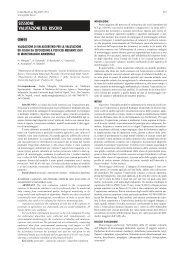03 comunic / libere /1 - Giornale Italiano di Medicina del Lavoro ed ...
03 comunic / libere /1 - Giornale Italiano di Medicina del Lavoro ed ...
03 comunic / libere /1 - Giornale Italiano di Medicina del Lavoro ed ...
Create successful ePaper yourself
Turn your PDF publications into a flip-book with our unique Google optimized e-Paper software.
G Ital M<strong>ed</strong> Lav Erg 20<strong>03</strong>; 25:3 Suppl COMUNICAZIONI - TEMI LIBERI<br />
www.gimle.fsm.it 211<br />
lieri. D’altro canto, fattori più strettamente organizzativi (ad es. ritmi,<br />
contemporaneità <strong>di</strong> lavorazioni e <strong>di</strong> persone presenti) possono spiegare<br />
le <strong>di</strong>fferenti incidenze nei primi 5 giorni <strong>del</strong>la settimana rispetto ai<br />
week-end e il picco <strong>del</strong>le 10-11 <strong>del</strong> mattino (quando invece la vigilanza<br />
e la performance sono solitamente ai livelli migliori). Lo stesso vale<br />
per il riscontro <strong>del</strong>la minore incidenza nel corso <strong>del</strong>la notte, su cui<br />
verosimilmente influiscono le <strong>di</strong>fferenti tipologie/con<strong>di</strong>zioni <strong>di</strong> lavoro<br />
tra turni <strong>di</strong>urni e turni notturni (ad es. fasi <strong>di</strong> lavoro, lavorazioni sospese,<br />
ritmi), sulle quali sono in corso ulteriori analisi approfon<strong>di</strong>menti,<br />
in particolare per quanto riguarda la <strong>di</strong>stribuzione degli infortuni<br />
nei <strong>di</strong>versi perio<strong>di</strong> <strong>del</strong>la giornata (mattino, pomeriggio, notte) nei<br />
lavoratori che effettuano anche lavoro notturno, sia in ciclo continuo<br />
che <strong>di</strong>scontinuo.<br />
Tabella I. Distribuzione degli infortuni per anno e gravità<br />
0<br />
Classi <strong>di</strong> gravità (giorni <strong>di</strong> assenza)<br />
1-3 4-30 >30<br />
totale<br />
I.F<br />
(X milione<br />
N° 5 N° % N° % N° % N° % ore lav.)<br />
1999 346 54,4 36 5,6 173 27,2 80 12,5 635 100 376<br />
2000 300 52,6 42 5,3 140 24,5 88 15,4 570 100 400<br />
2001 247 52,0 24 5,0 126 26,5 78 16,4 475 100 367<br />
2002 329 62,2 14 2,6 108 20,6 73 13,9 524 100 375<br />
totale 1222 55,4 116 5,3 547 24,8 319 14,5 2204 100<br />
Figura 1. Andamento <strong>del</strong> Tasso <strong>di</strong> Incidenza nelle 24 ore<br />
Bibliografia<br />
Åkerst<strong>ed</strong>t T. Shift work and <strong>di</strong>sturb<strong>ed</strong> sleep/wakefulness. Occup M<strong>ed</strong><br />
20<strong>03</strong>; 53: 89-94.<br />
Costa G. Shift work and occupational me<strong>di</strong>cine: an overview. Occup M<strong>ed</strong><br />
20<strong>03</strong>; 53: 83-88.<br />
Folkard S, Tucker P. Shift work, safety and productivity. Occup M<strong>ed</strong><br />
20<strong>03</strong>; 53: 95-101.<br />
Hänecke K, Ti<strong>ed</strong>emann S, Nachreiner F, Grzech-Sukalo H. Accident risk<br />
as a function of hour at work and time of day as determin<strong>ed</strong> from accident<br />
data and exposure mo<strong>del</strong>s for the German working population.<br />
Scand J Work Environ Health 1998; 24 (suppl 3): 43-48.

















